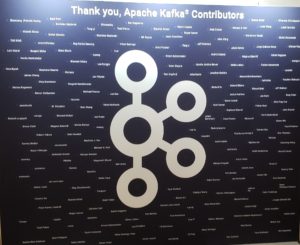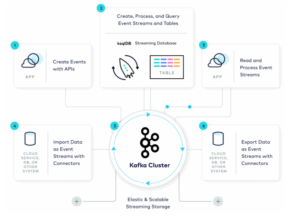
Intimidated by Kafka? Check Out Confluent’s New Developer Site

If you’re new to Kafka and developing event streaming platforms, it’s easy to get overwhelmed. This is an entirely different architecture than what most developers are used to, after all. But that fear should be only temporary, as Confluent this week rolled out a new website (developer.confluent.io) aimed at easing developers into the Kafka and streaming fold.
There’s no shortage of resources for Kafka developers across the Web. That’s a side effect of the immense popularity of Kafka. But just the same, ever since Tim Berglund took the developer’s advocate job at Confluent over four years ago, he’s been itching to build a site like the new Confluent Developer.
“We’ve got all this stuff. There’s recorded meetups and there’s recorded conference talks and [Kafka] Summit talks and demos and all kinds of code on GitHub and podcasts and blog posts and everything,” says Berglund, who’s official title is senior director of developer advocacy.
“But asking people to Google–I mean, that’s normal behavior. But I want them to be home,” he continues. “There’s got to be one URL. There’s got to be one place. That’s core to my vision of developer relations. That needs to be a website. That’s the website where you send people. And so it needs to live there.”
The revamped Confluent Developer website (it has existed for over a year) is a veritable smorgasbord of resources for Kafka developers. At a high level, it has nine recorded video courses, 50 software design patterns, seven “getting started” guides tailored to different programming languages, three new “quick starts, and 13 learning pages.
The video courses (which feature Berglund and other Confluent pros) explore various Kafka topics, ranging from the basics (Apache Kafka 101) to more advanced topics (Data Mesh 101). Each of these courses is composed of multiple videos, which are broken up into short (2-10 minute) chunks that are more easily digested by today’s busy developers.

What is an event? Confluent’s senior director of developer advocacy, Tim Berglund, describes it in the Kafka 101 course
If you’re entirely new to Kafka, Berglund recommends starting with his Kafka 101 course, which features more than 70 minutes of video and text aimed at describing the basic foundations of Kafka and the core elements of an event streaming architecture.
“That’s going to give you a very gentle introduction to the idea of what an event is, the notion of logging events, and then the layers of the Kafka ecosystem that are kind of added on to that very elemental core,” Berglund says. “You’ve got this event log. I’m trying to get them to understand the idea of a log of events.
“But that by itself is easy to understand and hard to build things out of, so you need these layers on top of it,” he continues. “That Kafka 101 course gently introduces you, a piece at a time, to that whole ecosystem. It usually gets people from zero to, if not hero, at least a comfortable person in the space of about an hour.”
If you’re curious how Kafka works with Java, Python, Go, .NET, REST, SQL, or C/C+, then you might be interested in the tutorials hosted under the “getting started” guides. Users can also start to play around with Kafka running on the Confluent Cloud through the “quick start” mechanism.
Patterns are also making their debut with the relaunch of Confluent Developer. The enterprise computing world is no stranger to patterns as first described in the original 1995 book “Design Patterns: Elements of Reusable Object-Oriented Software,” written by the “Gang of Four.” Now Confluent is borrowing a page out of that book to help Kafka developers think more holistically about how things fit together in the new event streaming paradigm.
“We’re just taking that patterns motif and applying it to event streaming problems, like how to do a database write aside, or an event source connector, or how to compact an event stream,” Berglund says. “These are all the things that you’re going to have to do when you’re building something based on event-driven architecture, and we just collected 50 or so of them for a first pass and build them out, diagramed them, and said, now you have a recipe book.”

“One of the things that makes Kafka exciting is that it isn’t just another data store; it’s really something quite different,” writes Confluent CEO Jay Kreps in an Aug 4 blog post.
Patterns have been cooking for a while inside of Confluent. It’s not so much giving developers cookie-cutter code they can stamp out, but to show them how various components can be used to build streaming data applications.
“If you compare it to the perceived paradigm, like the default way people build an application, now there’s a database and there’s a big application around it and that application grows and that database grows,” Berglund says. “Everybody knows how to build a monolith. They know their favorite language and their favorite framework and their favorite database and they’re super comfy.
“Now come over to the event streaming world, and everybody is like, now I know what that that paradigm can do,” he continues. “It’s proven. There are stories. I get the architectural properties that event streaming is offering to me, and I need them. But I don’t know how to build those things. We [built] a course. So we’re trying to ease that path.”
There is no cost to access Confluent Developer. In fact, Confluent, which recently went public and just reported its first quarterly results, doesn’t even require you to sign in. The resources are just sitting there on a static website, free for anybody to consume.
Related Items:
Confluent Raises More Than $800M in IPO
Confluent S-1 Reveals ‘Reimagining of Business’ Theme
Three Takeaways from Jay Kreps’ Kafka Summit Keynote






























